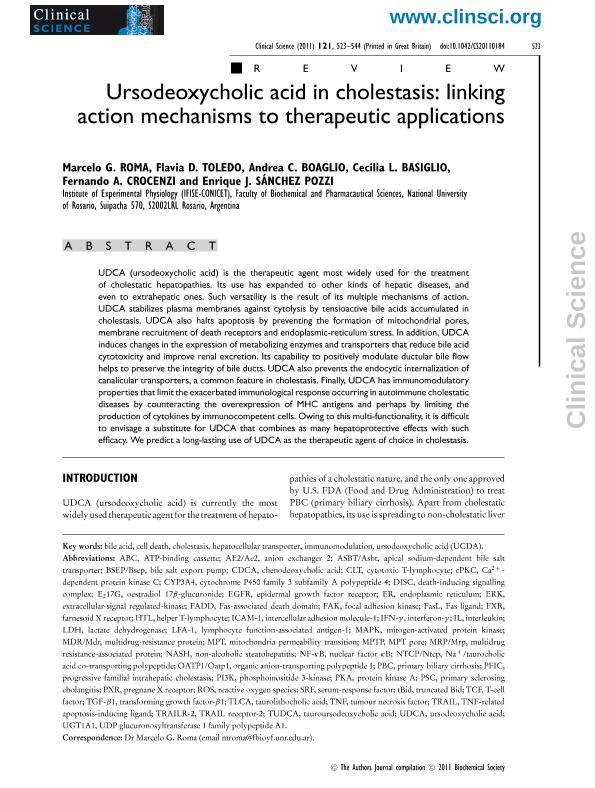Artículo
Ursodeoxycholic acid in cholestasis: linking action mechanisms to therapeutic applications
Roma, Marcelo Gabriel ; Toledo, Flavia Daniela
; Toledo, Flavia Daniela ; Boaglio, Andrea Carolina
; Boaglio, Andrea Carolina ; Basiglio, Cecilia Lorena
; Basiglio, Cecilia Lorena ; Crocenzi, Fernando Ariel
; Crocenzi, Fernando Ariel ; Sanchez Pozzi, Enrique Juan
; Sanchez Pozzi, Enrique Juan
 ; Toledo, Flavia Daniela
; Toledo, Flavia Daniela ; Boaglio, Andrea Carolina
; Boaglio, Andrea Carolina ; Basiglio, Cecilia Lorena
; Basiglio, Cecilia Lorena ; Crocenzi, Fernando Ariel
; Crocenzi, Fernando Ariel ; Sanchez Pozzi, Enrique Juan
; Sanchez Pozzi, Enrique Juan
Fecha de publicación:
12/2011
Editorial:
Portland Press
Revista:
Clinical Science
ISSN:
0143-5221
e-ISSN:
1470-8736
Idioma:
Inglés
Tipo de recurso:
Artículo publicado
Clasificación temática:
Resumen
UDCA (ursodeoxycholic acid) is the therapeutic agent most widely used for the treatment of cholestatic hepatopathies. Its use has expanded to other kinds of hepatic diseases, and even to extrahepatic ones. Such versatility is the result of its multiple mechanisms of action. UDCA stabilizes plasma membranes against cytolysis by tensioactive bile acids accumulated in cholestasis. UDCA also halts apoptosis by preventing the formation of mitochondrial pores, membrane recruitment of death receptors and endoplasmic-reticulum stress. In addition, UDCA induces changes in the expression of metabolizing enzymes and transporters that reduce bile acid cytotoxicity and improve renal excretion. Its capability to positively modulate ductular bile flow helps to preserve the integrity of bile ducts. UDCA also prevents the endocytic internalization of canalicular transporters, a common feature in cholestasis. Finally, UDCA has immunomodulatory properties that limit the exacerbated immunological response occurring in autoimmune cholestatic diseases by counteracting the overexpression of MHC antigens and perhaps by limiting the production of cytokines by immunocompetent cells. Owing to this multi-functionality, it is difficult to envisage a substitute for UDCA that combines as many hepatoprotective effects with such efficacy. We predict a long-lasting use of UDCA as the therapeutic agent of choice in cholestasis.
Palabras clave:
Bile Acids
,
Cholestasis
,
Hepatocellular Transporter
,
Udca
Archivos asociados
Licencia
Identificadores
Colecciones
Articulos(IFISE)
Articulos de INST.DE FISIOLOGIA EXPERIMENTAL (I)
Articulos de INST.DE FISIOLOGIA EXPERIMENTAL (I)
Citación
Roma, Marcelo Gabriel; Toledo, Flavia Daniela; Boaglio, Andrea Carolina; Basiglio, Cecilia Lorena; Crocenzi, Fernando Ariel; et al.; Ursodeoxycholic acid in cholestasis: linking action mechanisms to therapeutic applications; Portland Press; Clinical Science; 121; 12; 12-2011; 523-544
Compartir
Altmétricas



